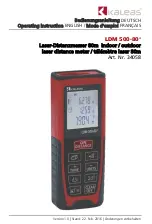
55
12 Calibrating
a pH measuring chain
12.1
Important information
12.2
General information
The calibration of pH electrodes is based on measurements in buffer solutions
with a defined pH-value. The pH values of the buffer solutions used are specified
either via entry of fixed values into the calibration default settings, entered during
the calibration or recognized automatically by "automatic buffer recognition"
during the calibration process. For "automatic buffer recognition", a buffer set ta-
ble must be selected in the calibration default settings. In this case, the buffer
solutions used must be listed in the provided buffer set table. Since pH value
measurement of liquids is temperature-dependent, the temperature of the buffer
solution must be sensed in order to compensate for its effect on the result of the
measurement. This requires either manual entry or measurement with the aid of
a temperature sensor.
12.2.1
Calibration methods for pH sensors
Zero-point calibration
This calibration method is used to determine the pH zero point on the measure-
ment characteristic curve. The slope is retained.
A buffer solution with a defined pH value is needed as a reference.
Two-point Calibration
By measuring 2 different buffer solutions with defined pH values, the pH zero
point and pH slope of the measuring chain are established.
The pH values of the buffer solutions must be at least 2 pH apart. This calibration
method is recommended for most applications.
Three-point calibration
With a three-point calibration, the pH zero point as well as the pH slope in the
acidic region and the pH slope in the alkaline region are established. The three-
point calibration can be performed only for pH sensors on analysis inputs. It is
not available for JUMO digiLine pH sensors.
This method requires 3 buffer solutions with defined pH-values as references.
One of these must be acidic, one neutral and one alkaline. The pH values of the
buffer solution must be at least 2 pH apart from one another. This calibration
method is recommended for applications with more demanding accuracy re-
quirements when performing measurements in both the alkaline and acidic re-
gions.
WARNING!
During the calibration, the relays and the analog output signals assume the
states configured under the respective "Response at calibration' configuration
points for the analog and digital outputs!
Summary of Contents for AQUIS touch S
Page 8: ...Inhalt ...
Page 20: ...10 Configuration 20 Chapter 10 12 Calibration timer page 46 ...
Page 68: ...13 Calibrating redox sensors 68 ...
Page 78: ...15 Calibrating CR conductivity sensors 78 ...
Page 88: ...16 Calibrating Ci conductivity sensors 88 ...
Page 96: ...17 Calibrating universal inputs 96 ...
Page 106: ...18 Calibrating O DO sensors 106 ...
Page 146: ...21 Annex 146 ...
Page 147: ......
Page 148: ......
Page 149: ......
















































